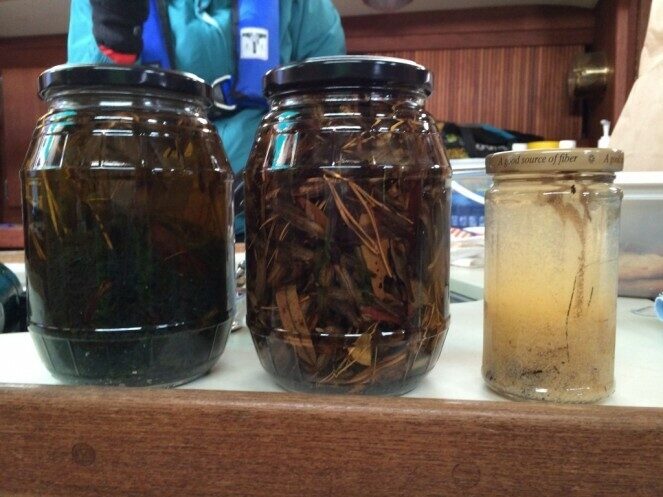Scout’s Trash Trawl Expedition on the Chesapeake Bay

 Some of you may remember Scout the water bottle who we first heard about in Jenifer Chambers cronicles the adventures of Scout in her book entitled ”Watershed Adventures of a Water Bottle” Today Jenifer shares the story of Scouts latest adventure on the Chesapeake, as he takes embarkes on a journey with Trash Free Maryland and 5 Gyres to assess plastic pollution in the Bay.
Some of you may remember Scout the water bottle who we first heard about in Jenifer Chambers cronicles the adventures of Scout in her book entitled ”Watershed Adventures of a Water Bottle” Today Jenifer shares the story of Scouts latest adventure on the Chesapeake, as he takes embarkes on a journey with Trash Free Maryland and 5 Gyres to assess plastic pollution in the Bay.
Last Friday, Scout, the water bottle from Watershed Adventures of a Water Bottle, participated in a cold adventure on the Chesapeake Bay with Trash Free Maryland and 5 Gyres. Under bright blue skies with the sun rising from the east, Scout ventured on the Obtuse in search of plastic peers. Never before had a mantra trawl been used on the Chesapeake Bay to learn how much and what kind of plastic pollution was suspended in the water. Scout traveled on the Obtuse from Herring Bay to the mouth of the South River where the mantra trawl was dropped into the choppy Bay and held off the port side with a boom. There it bobbed and sieved brackish water as the Obtuse traveled slowly south. The mantra trawl was designed by Markus Eriksen, 5 Gyres Director of Research, from the mantra ray whose mouth agapes to strain plankton while traveling over great distances (biomimicry). GPS coordinates and time were recorded and the samples were retrieved from the Bay after 60 and 30 minutes of floating. The tail of the trawl’s sock is removed and flushed with water into a bucket where it is then poured through a very fine pan strainer. Any leaves or biomass are carefully checked and rinsed to capture even the smallest pieces of plastic. The pan strainer is scrapped into a glass jar where alcohol is poured to preserve and separate the particles.In Friday’s samples, the water’s surface lacked concentrations of plastic pollution due to high winds and rough water that push plastic particles down the water column.
These samples had high concentrations of salps, type of plankton, with only a few observable pieces of plastic pollution, one being a candy wrapper corner and a piece of fishing line. However, Wednesday’s sample from a calm Bay contained a high concentration of plastic pollution, which varied in size from a few millimeters to less than one millimeter flouting amongst algae that provided an easy background to see the plastic particles. Most of the plastic pollution were shreds of white and black plastic but also uniformly round blue and white balls were observed; the blue balls are microbeads found in beauty care products and the white balls are styrafoam packing. Plastic microbeads are commonly found in beauty care products such as toothpastes, face and body scrubs and hand cleansers to exfoliate. Companies choice plastic over natural exfoliants like ground fruit pits because of their smooth uniformity. These microbeads don’t get strained out of waste water when treated by municipalities creating an environmental impact on aquatic ecosystems. Microbeads flow back into our rivers where they become a part of the food web. Stiv Wilson from 5 Gyres explains the impact this has on fish in our rivers, lakes and oceans. Scout recommends you take these actions to reduce #plasticpollution in the Chesapeake Bay:
1. Remove from your linen closet, bathroom drawers and medicine cabinet any toothpaste, face and body scrubs and hand cleansers that contain polyethylene in the ingredient list.
2. Reduce your single use plastic consumption. Use reusable bags instead of plastic from the grocery store. Pack a reusable water bottle and refill it with tap water instead of buying expensive bottled water. Bring your travel mug next time you visit Starbucks for your much needed caffeine fix. Pack your lunch in reusable containers and throw real silverware into your lunch box (go to the thrift store and buy mismatched silverware for your lunch box). Go retro and use a metal straw instead of plastic – one of the top 10 items cleaned up during International Coastal Cleanup Day each year.
3.Advocate to local and state representatives to enact reusable bag, bottle return and microbead ban legislation.
4.Pick-up litter. Imagine our communities if every person picked up one piece of litter each day for a year. Create that photo in your mind of your favorite place without litter. Imagine!
5. Buy a copy of Watershed Adventures of a Water Bottle and read or give it to a child. 100% of the book’s profit is donated to the Chesapeake Bay Trust who supported this four-day research trip on the Chesapeake Bay to investigate plastic pollution.
5. Alison Gillespie at Where We Are Planted participated in the four-day research trip to trawl for plastic pollution on the Chesapeake Bay. Read her perspective in Finding Trash in the Chesapeake Bay.
For more info on Scouts trip, and to hear more from Jennifer check out her Blog!
